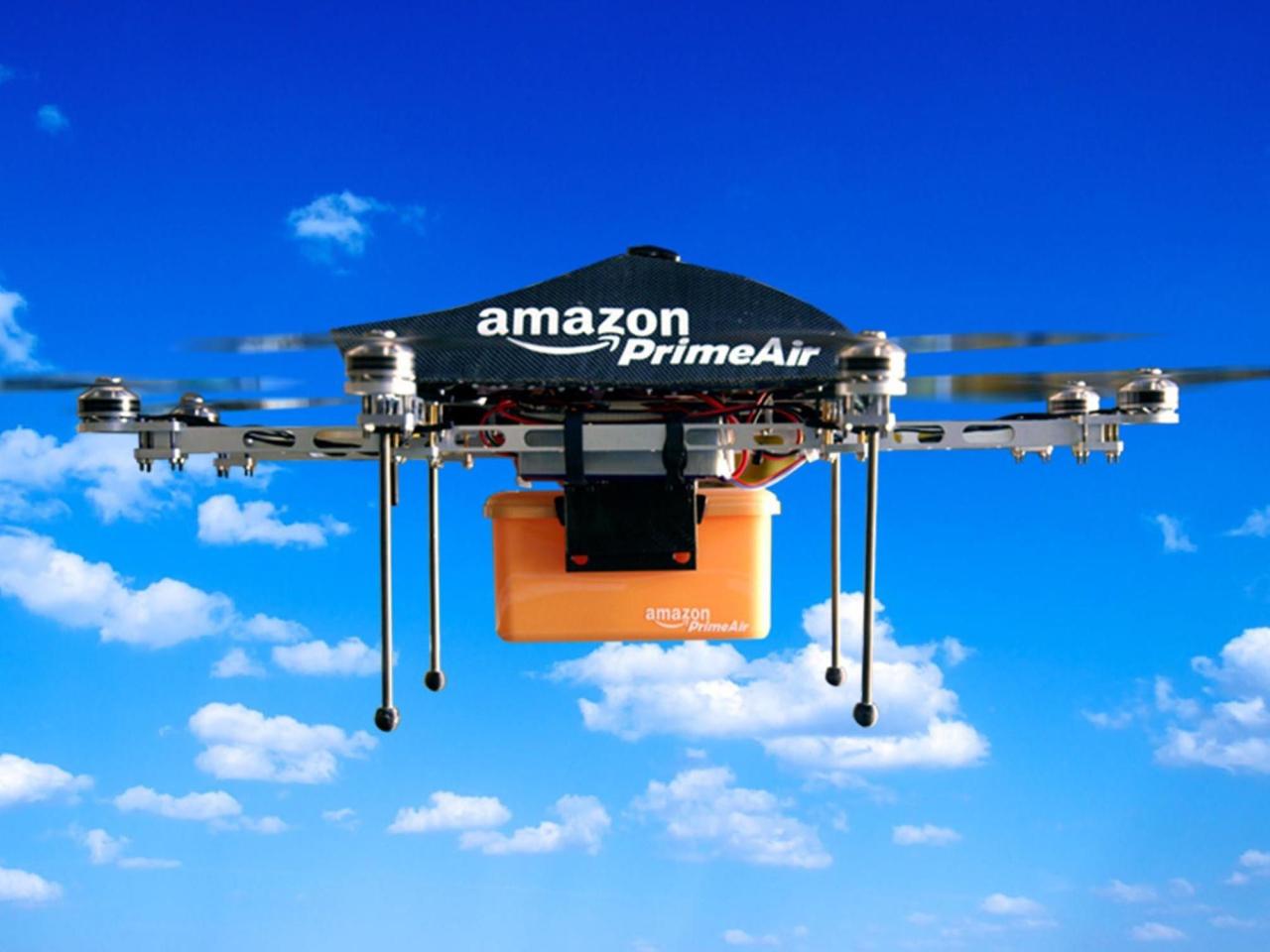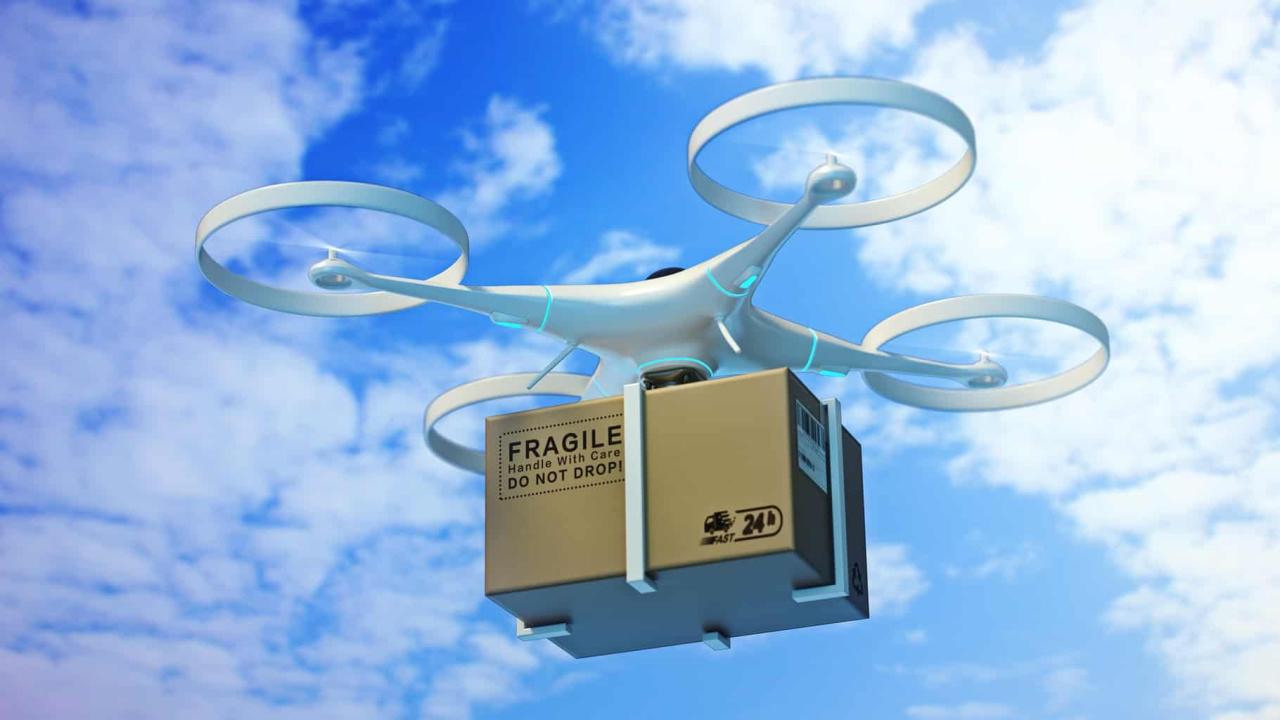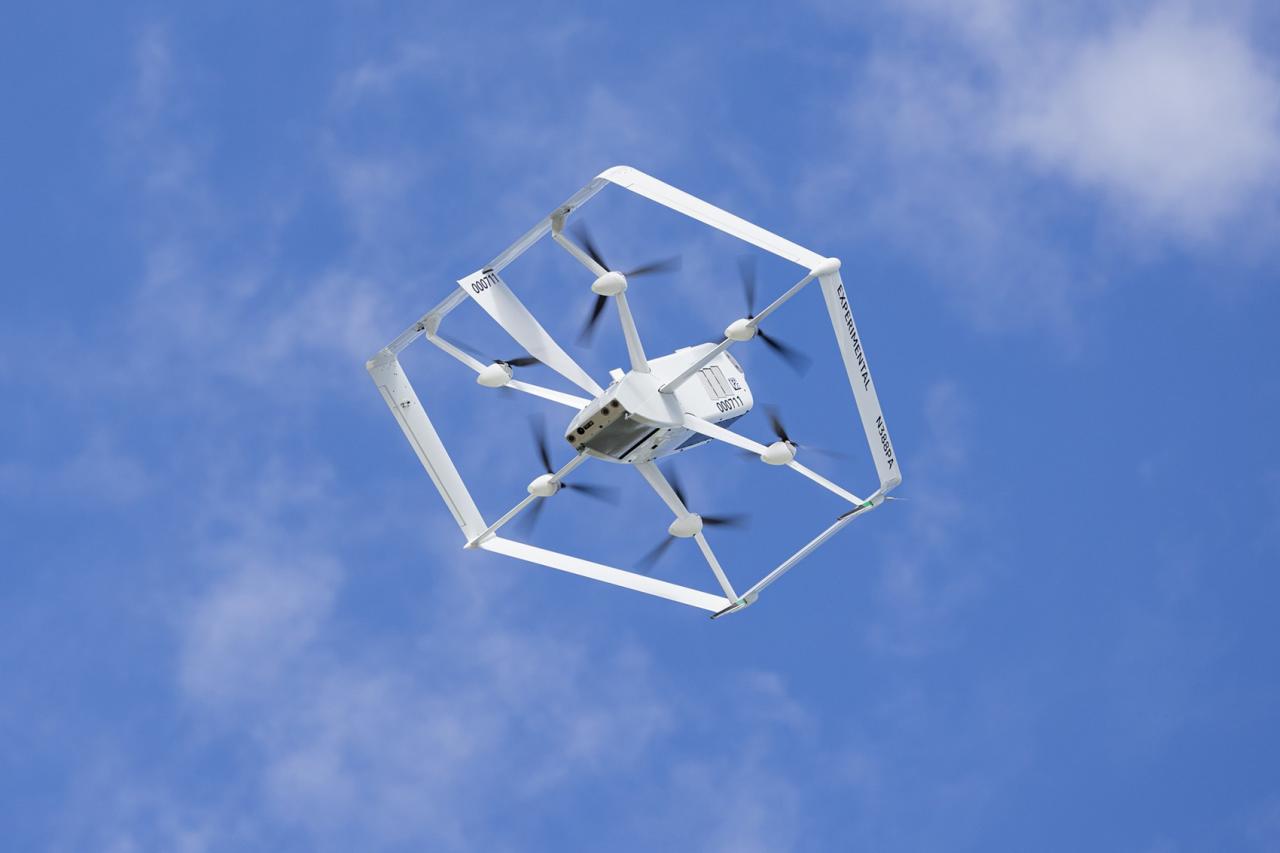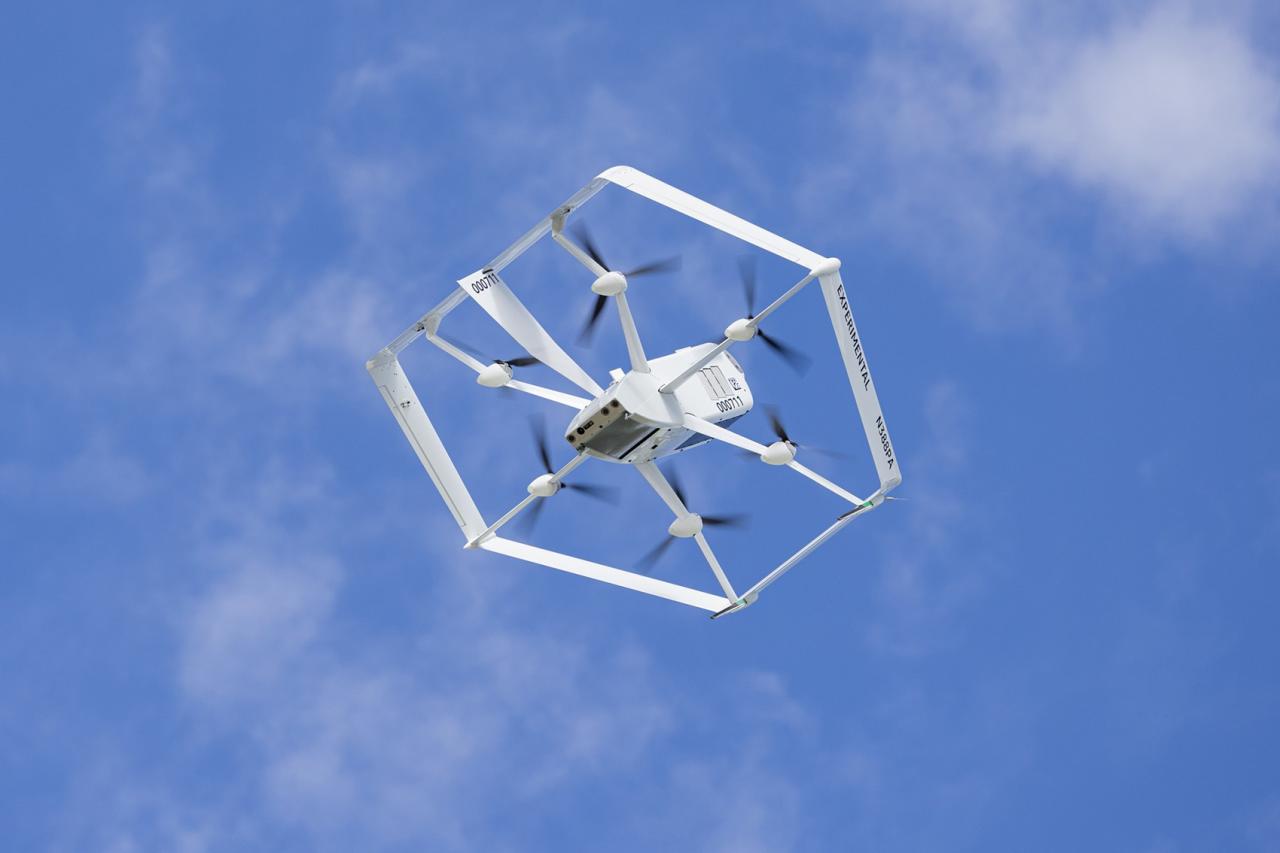Amazon drone delivery locations are rapidly expanding, revolutionizing how we receive packages. This isn’t just about faster shipping; it’s about reimagining logistics, infrastructure, and even urban planning. We’ll explore the current landscape of Amazon’s drone delivery program, examining the factors driving location selection, the necessary infrastructure, safety protocols, and the evolving customer experience.
From the technological hurdles to the regulatory approvals and community acceptance, the journey of a package from warehouse to doorstep via drone is a fascinating blend of engineering, policy, and public perception. This exploration will delve into the details, providing a comprehensive overview of this exciting and rapidly developing area of delivery.
Current Amazon Drone Delivery Program Status
Amazon’s drone delivery program, officially known as Amazon Prime Air, is steadily progressing, though it’s still in a relatively early stage of widespread deployment. While not yet a ubiquitous service, it represents a significant step towards faster and more efficient delivery methods. The program is continuously evolving, expanding its reach and capabilities.Amazon Prime Air’s current operational scope is limited to specific locations.
It’s not a nationwide service, and availability is highly dependent on factors like airspace regulations, population density, and the existing infrastructure.
Geographical Scope of Amazon Drone Delivery
Currently, Amazon Prime Air operates in select areas within the United States. These locations are carefully chosen based on factors such as population density, regulatory approvals, and the feasibility of establishing efficient drone delivery routes. The exact number and locations of operational areas are not consistently publicized by Amazon, but reports indicate a focus on suburban and less densely populated regions where drone operations are easier to manage and integrate with existing logistics.
This strategic approach allows Amazon to refine its operations and technology before expanding into more complex urban environments.
Types of Goods Eligible for Drone Delivery
The types of packages suitable for drone delivery are restricted by weight and size limitations imposed by the drones themselves and safety regulations. Generally, only smaller, lighter packages are currently eligible. This typically includes items such as everyday household goods, small electronics, and books. Larger or heavier items remain outside the scope of current drone delivery capabilities.
Amazon actively manages the selection of eligible items to ensure safety and operational efficiency. The range of eligible products may expand as drone technology and regulations evolve.
Technological Infrastructure Supporting Amazon Drone Delivery
Amazon Prime Air relies on a sophisticated technological infrastructure to support its operations. This includes a network of drone hubs, sophisticated flight control systems, advanced sensors and navigation technology, and robust communication networks. The drones themselves are equipped with obstacle avoidance systems, GPS, and other technologies to ensure safe and autonomous flight. Amazon’s system also involves extensive software for route planning, package tracking, and real-time monitoring of drone operations.
This intricate network requires significant investment in both hardware and software development.
Timeline of Significant Milestones in Amazon Drone Delivery
Amazon’s drone delivery program has seen several key milestones since its inception. While precise dates for all internal developments are not publicly available, key public achievements include initial test flights and demonstrations showcasing the technology’s capabilities. Subsequent milestones involve securing regulatory approvals, expanding testing areas, and gradually increasing the number of deliveries made. The program’s timeline reflects a phased approach, prioritizing safety and regulatory compliance alongside technological advancement.
The transition from experimental phases to limited commercial operations marks a significant achievement in the program’s progress.
Factors Influencing Drone Delivery Location Selection: Amazon Drone Delivery Locations

Choosing the right locations for Amazon’s drone delivery program is crucial for its success. Several interconnected factors determine the feasibility and efficiency of drone operations, ranging from logistical considerations to regulatory hurdles and environmental impacts. Careful evaluation of these factors is essential for optimizing delivery routes and ensuring a safe and reliable service.
Logistical considerations play a significant role in site selection. These considerations involve balancing the needs of efficient drone operations with the realities of diverse geographical areas. Key aspects include population density, existing infrastructure, and the complex web of airspace regulations.
Population Density and Infrastructure
Population density directly impacts the potential demand for drone delivery services. Densely populated urban areas offer a large customer base but present challenges related to airspace congestion and navigation around buildings. Suburban areas often provide a more manageable airspace, but may require longer delivery distances to reach dispersed customers. Rural areas, while offering wide-open airspace, present the challenge of lower population density, potentially making the service less economically viable unless demand can be aggregated effectively, for example, through partnerships with rural healthcare providers or other businesses.
Amazon’s expanding drone delivery locations are pretty cool, right? But safe operation is key; think about the recent mishap, check out this article on the orlando drone show accident , to see how things can go wrong. Learning from incidents like this is crucial for ensuring the future success of Amazon’s drone delivery program and for keeping everyone safe.
Existing infrastructure, such as suitable landing zones and reliable internet connectivity for drone communication and control, is also crucial for all location types. The availability of charging stations and maintenance facilities is also a major factor.
Airspace Regulations and Community Acceptance
Drone operations are subject to strict airspace regulations that vary by country and region. Obtaining the necessary permits and approvals can be a time-consuming process. Furthermore, successful implementation requires community acceptance. Addressing concerns about noise pollution, privacy, and potential safety risks is essential to gaining public support and ensuring smooth operations. Amazon’s proactive engagement with local communities and regulatory bodies is critical for overcoming these hurdles.
For instance, a successful launch might involve community meetings to address concerns and transparent communication about safety protocols.
Impact of Weather Conditions
Weather conditions significantly impact the operational feasibility of drone deliveries. Inclement weather, such as heavy rain, snow, strong winds, or fog, can ground drones and disrupt operations. Urban areas might experience more frequent disruptions due to localized weather patterns compared to more open suburban or rural environments. However, even in seemingly favorable weather conditions, unexpected changes can affect flight safety.
Therefore, robust weather monitoring systems and contingency plans are crucial for maintaining operational reliability across different locations. For example, Amazon might employ sophisticated weather forecasting models and real-time weather data integration into their drone flight planning systems to minimize disruptions.
Infrastructure Requirements for Drone Delivery Locations
Setting up a successful drone delivery operation requires careful planning and investment in the right infrastructure. This includes not only the landing zones where drones will drop off packages but also the supporting facilities needed for charging, maintenance, and overall operational efficiency. Ignoring these infrastructural needs can lead to significant delays, increased costs, and potentially safety hazards.
A well-designed infrastructure ensures smooth and reliable drone operations, maximizing delivery efficiency and minimizing downtime. This section details the essential components of a hypothetical infrastructure plan for a new drone delivery location, along with cost estimations and maintenance considerations. We’ll also explore examples from existing drone delivery programs and compare different types of landing pads.
Hypothetical Infrastructure Plan for a New Drone Delivery Location
This plan Artikels the necessary infrastructure for a medium-sized drone delivery hub servicing a suburban area. The design prioritizes safety, efficiency, and scalability.
The central hub will consist of a secure, fenced-in area encompassing multiple landing zones, a charging station, a maintenance facility, and a small office space for personnel. Landing zones will be strategically positioned to minimize flight times and maximize efficiency. The charging station will use a standardized, easily replaceable battery system, allowing for rapid swapping and minimizing downtime.
Amazon’s planning drone delivery locations is a complex process, needing careful consideration of airspace and population density. Recent incidents, like the one described in this article about a paris drone crash , highlight the safety challenges involved. Understanding these risks is crucial for determining the best locations for safe and efficient drone delivery services in the future.
The maintenance facility will be equipped with tools and parts for routine maintenance and repairs. The office space will accommodate a small team to manage operations, monitor flights, and address any issues.
Infrastructure Component Costs and Maintenance
| Component | Estimated Cost (USD) | Maintenance Requirements | Frequency |
|---|---|---|---|
| Landing Zones (5) | $5,000 – $15,000 | Regular cleaning, inspection for damage | Daily/Weekly |
| Charging Station (10 bays) | $10,000 – $25,000 | Regular inspection of charging cables, battery health monitoring | Daily |
| Maintenance Facility (small building) | $50,000 – $150,000 | Routine building maintenance, equipment upkeep | Monthly/Annually |
| Security System (fencing, cameras) | $10,000 – $30,000 | Regular camera maintenance, system updates | Monthly |
| Software and Communication Systems | $20,000 – $50,000 | Software updates, network maintenance | Ongoing |
Note: Costs are estimates and can vary significantly based on location, materials, and specific requirements.
Examples of Existing Infrastructure Solutions
Several companies are already operating drone delivery programs, providing real-world examples of successful infrastructure implementation. For instance, Wing Aviation, a subsidiary of Alphabet, utilizes small, designated landing pads on customers’ lawns or in designated community areas. These pads are often simple, low-cost structures, emphasizing ease of deployment and minimal environmental impact. Other companies, such as Amazon, are investing in more sophisticated infrastructure, including larger landing zones at strategically located hubs.
These hubs act as central distribution points for drones servicing larger areas. These examples highlight the diversity of approaches to infrastructure design, tailored to specific operational needs and geographical constraints.
Comparison of Drone Landing Pad Types
| Material | Size (approx.) | Environmental Impact | Advantages |
|---|---|---|---|
| Concrete | 4ft x 4ft | High embodied carbon, potential for runoff | Durable, weather-resistant |
| Recycled Plastic | 3ft x 3ft | Lower embodied carbon, recyclable | Durable, lightweight, customizable |
| Grass/Soil | Variable | Low impact, natural | Low cost, aesthetically pleasing, but weather dependent |
| Fabric/Textile | Variable | Moderate, depending on material | Lightweight, portable, easily deployable |
The choice of landing pad material depends on factors such as cost, durability, environmental impact, and the specific requirements of the delivery location. For example, a concrete pad might be preferred in high-traffic areas, while a grass landing zone could be more suitable for residential areas where minimizing visual impact is a priority.
Safety and Security Aspects of Drone Delivery Locations

Safe and secure drone delivery locations are paramount for the success of this emerging technology. Minimizing risks to both people and property, while preventing package theft, requires careful planning and implementation of robust safety and security protocols. This section details the measures taken to ensure the safe and efficient operation of Amazon’s drone delivery program.
Safety Protocols for Drone Operations Near Residential Areas
Drone operations near residential areas necessitate stringent safety measures. These protocols aim to minimize the risk of accidents involving drones, people, or property. Amazon utilizes sophisticated flight planning software to identify and avoid obstacles, including power lines, trees, and buildings. Furthermore, drones are equipped with multiple redundancies in their flight control systems, ensuring a safe landing even in the event of a system malfunction.
Geofencing technology restricts drone flight to pre-approved areas, preventing accidental incursions into restricted airspace. Regular maintenance and inspections of drones are also crucial for preventing mechanical failures. Finally, Amazon employs highly trained drone pilots who undergo rigorous training and certification programs.
Security Measures to Prevent Unauthorized Access or Theft of Packages, Amazon drone delivery locations
Preventing unauthorized access to packages and theft is critical. Amazon employs several security measures, including secure package containers that are difficult to open without the proper tools. These containers are often equipped with GPS trackers, allowing for real-time monitoring of their location. The delivery process is designed to minimize the time packages spend unattended. Drones deliver packages directly to designated drop-off zones, often within a customer’s yard or a secure location.
Furthermore, Amazon uses advanced encryption techniques to protect package tracking information and customer data. Surveillance cameras at designated delivery locations are sometimes used as an added security layer, providing visual monitoring of the drop-off process.
Potential Environmental Hazards and Mitigation Strategies
While drone delivery offers environmental benefits over traditional delivery methods, potential environmental hazards exist. Noise pollution from drone propellers is a concern, particularly in quiet residential areas. Amazon is actively working on reducing drone noise levels through technological advancements in propeller design and quieter motor technology. The potential for drone battery malfunctions and subsequent environmental damage (such as fire or chemical leaks) is addressed through rigorous testing and quality control of batteries.
Moreover, Amazon is committed to responsible battery disposal and recycling programs to minimize environmental impact. The risk of collisions with wildlife is mitigated through careful flight planning and adherence to established flight corridors.
Safety and Security Checklist for Drone Delivery Location Operators
A comprehensive checklist ensures the consistent application of safety and security measures. This checklist should be reviewed and updated regularly to reflect any changes in technology or regulations.
- Verify the designated drop-off zone is free from obstacles and hazards.
- Confirm the area is adequately lit for nighttime deliveries.
- Ensure the drone’s flight path avoids potential hazards, such as power lines and trees.
- Inspect the drone’s battery and other components before each flight.
- Regularly maintain and update drone software and firmware.
- Implement a robust security system to prevent package theft.
- Monitor drone operations using real-time tracking and surveillance systems.
- Comply with all applicable local, state, and federal regulations.
- Establish a procedure for handling incidents and emergencies.
- Conduct regular safety training for all personnel involved in drone operations.
Customer Experience and Public Perception
Amazon’s drone delivery program aims to revolutionize the last mile of delivery, but its success hinges on a positive customer experience and widespread public acceptance. This requires careful consideration of several key factors, from the ease of the delivery process to addressing public concerns about noise, privacy, and safety.The customer journey begins with placing an order through the Amazon app, just as with traditional deliveries.
Once the order is eligible for drone delivery, the customer receives a notification indicating the estimated delivery time. They can then track the drone’s progress in real-time through the app, providing visual updates of its location and anticipated arrival. Upon arrival, the drone autonomously lowers the package to a designated safe location, often a customer’s backyard. A notification confirms successful delivery, and the customer can then retrieve their package.
This entire process is designed to be seamless and convenient, offering a futuristic twist on a familiar experience.
Customer Experience from Ordering to Receiving a Drone-Delivered Package
The customer journey is designed for simplicity and transparency. Customers place orders as usual, but eligible items are flagged for drone delivery. Real-time tracking provides peace of mind, allowing customers to follow their package’s journey. Upon arrival, the drone utilizes a sophisticated system to gently lower the package, minimizing risk of damage. Post-delivery notifications ensure a smooth conclusion to the process.
The entire experience aims to be more convenient than traditional delivery methods, offering a faster and more efficient service.
Examples of Successful Public Awareness Campaigns Promoting Drone Delivery
While specific details of campaigns may vary based on location and regulation, successful campaigns emphasize the benefits of drone delivery, such as reduced traffic congestion, faster delivery times, and environmental friendliness. Visuals often feature sleek drones efficiently navigating the skies, delivering packages to happy customers. Educational materials highlight safety measures and address potential concerns proactively. For example, a campaign might showcase the drone’s quiet operation and its ability to avoid populated areas, mitigating noise and safety concerns.
Engaging social media content, interactive simulations, and community outreach programs can help build trust and foster acceptance.
Strategies to Address Public Concerns Regarding Noise Pollution, Privacy, and Safety
Addressing public concerns is crucial for the successful implementation of drone delivery. Noise pollution can be mitigated through the use of quieter drone designs and optimized flight paths. Privacy concerns can be addressed by employing technologies that prevent drones from capturing images or videos without explicit consent, and transparent data policies can reassure customers. Safety is prioritized through robust safety systems, redundant components, and rigorous testing procedures.
Clear communication about these measures through public awareness campaigns builds confidence and helps to overcome any apprehension. Furthermore, strict adherence to regulations and ongoing monitoring of operations are essential to maintaining public trust.
Comparison of Customer Feedback on Drone Delivery Versus Traditional Delivery Methods
The following points compare and contrast customer feedback on drone delivery versus traditional methods:
- Speed: Drone delivery consistently receives positive feedback for its speed and efficiency, often outperforming traditional methods, particularly in areas with congested traffic.
- Convenience: Drone delivery eliminates the need for customers to be home for delivery, as the package is autonomously delivered to a designated location. This is a major advantage highlighted in customer feedback.
- Reliability: Initial feedback might reveal inconsistencies in reliability due to weather conditions or technical issues. However, as technology improves and operational efficiency increases, reliability is expected to improve.
- Cost: The cost of drone delivery may initially be higher than traditional methods, though this is likely to decrease as the technology becomes more mainstream and efficient.
- Environmental Impact: Customers often appreciate the reduced carbon footprint associated with drone delivery compared to traditional delivery vehicles.
Future Expansion and Technological Advancements

Amazon’s drone delivery program, while currently in its relatively early stages, holds immense potential for future growth and expansion. The service’s success hinges on both geographical expansion and significant technological advancements that enhance efficiency, safety, and customer experience.The future of Amazon’s drone delivery service will likely involve a multi-pronged approach encompassing geographical expansion, technological improvements, and strategic integration with existing delivery systems.
This will allow for wider reach, increased efficiency, and a more robust and resilient delivery network.
So you’re curious about where Amazon’s delivering packages via drone, huh? It’s pretty cool tech! To get a clearer picture of the current rollout, check out this helpful resource on amazon drone delivery locations to see which areas are currently covered. Knowing these locations helps you understand the progress of Amazon’s drone delivery program and maybe even see if it’s coming to your neighborhood soon!
Geographic Expansion Plans
Amazon is likely to expand its drone delivery service to new geographic areas strategically, prioritizing regions with suitable infrastructure, favorable regulatory environments, and high population density. This might include expanding into more suburban and rural areas, provided that appropriate airspace management and safety protocols are established. We can expect to see a phased rollout, starting with areas that present fewer logistical challenges before tackling more complex terrains.
For example, expanding from existing concentrated urban areas to surrounding suburbs could be a logical next step, followed by carefully selected rural locations with relatively flat terrain and minimal obstacles. The company will likely focus on areas where the economic benefits of drone delivery outweigh the initial investment in infrastructure and regulatory compliance.
Technological Advancements in Drone Delivery
Several key technological advancements will significantly impact the efficiency and safety of Amazon’s drone delivery operations. Improved battery technology, allowing for longer flight ranges and heavier payloads, is crucial. Advances in autonomous navigation systems, incorporating AI and machine learning, will reduce the need for human intervention, increasing both efficiency and safety. This includes the development of more robust obstacle avoidance systems, capable of navigating complex urban environments and unpredictable weather conditions.
For instance, drones equipped with advanced sensor fusion technologies, combining data from multiple sensors such as lidar, radar, and cameras, will enable more precise navigation and obstacle detection. Furthermore, the development of more resilient drone designs, capable of withstanding harsh weather conditions and minor collisions, will further enhance safety and reliability.
Integration with Existing Delivery Methods
A hypothetical scenario could involve a seamless integration of drone delivery with existing ground-based delivery networks. For instance, drones could be used for the “last mile” delivery, transporting packages from a central distribution hub to individual customer addresses, while larger, heavier packages are transported via traditional trucking methods. This hybrid approach would leverage the strengths of both drone and ground-based delivery, optimizing efficiency and cost-effectiveness.
Amazon could strategically locate drone delivery hubs near existing fulfillment centers, minimizing transportation times and maximizing the utilization of both systems. This would also allow for a flexible and scalable delivery system, easily adjusting to fluctuating demand.
Vision for the Future of Drone Delivery and Societal Impacts
In the future, we envision a world where drone delivery is a common and accepted method of transporting goods, alongside existing delivery methods. This will lead to faster, more efficient, and potentially more environmentally friendly delivery services. Societal impacts could include reduced traffic congestion in urban areas, as fewer delivery trucks will be needed. However, considerations regarding privacy, security, and the potential displacement of jobs in the traditional delivery sector need to be addressed proactively.
The creation of robust regulatory frameworks and public education initiatives will be crucial to ensure a smooth and positive transition towards widespread drone delivery adoption. For example, we could see specialized drone delivery lanes in the sky, similar to current road systems, which would ensure safe and efficient drone traffic management.
Conclusive Thoughts
The future of Amazon drone delivery locations promises even greater efficiency and reach. As technology advances and regulations evolve, we can expect to see a wider rollout of drone delivery, transforming not only how we receive packages but also reshaping our cities and communities. The integration of drone delivery with other methods, such as traditional delivery networks, will optimize the entire supply chain, creating a more sustainable and efficient system for everyone.
This is more than just faster delivery; it’s a glimpse into a smarter, more connected future.
Helpful Answers
What types of packages can be delivered by Amazon drones?
Currently, Amazon drones deliver smaller, lighter packages. The exact size and weight limits vary depending on the drone model and location.
How much does drone delivery cost?
The cost is generally the same as standard shipping; it’s not a premium service. Pricing is determined by the standard Amazon shipping rates.
How long does drone delivery take?
Drone delivery times are significantly faster than traditional methods, often taking only 30 minutes or less, depending on distance and weather conditions.
What happens if there’s bad weather?
Amazon’s drone delivery service is weather-dependent. Flights are automatically suspended in adverse weather conditions, and deliveries are rescheduled.
Is my privacy protected during drone delivery?
Amazon employs various privacy measures, including adhering to strict airspace regulations and using drones equipped with advanced sensors and cameras that prioritize privacy.
